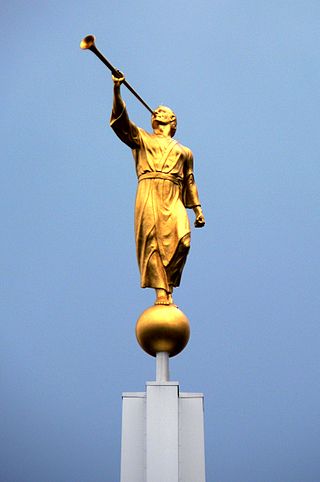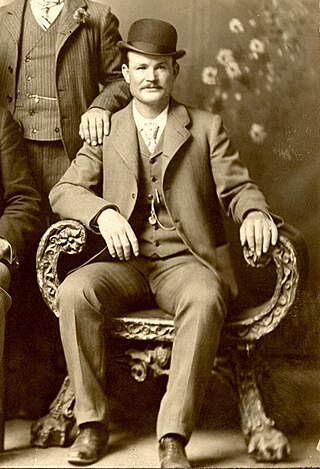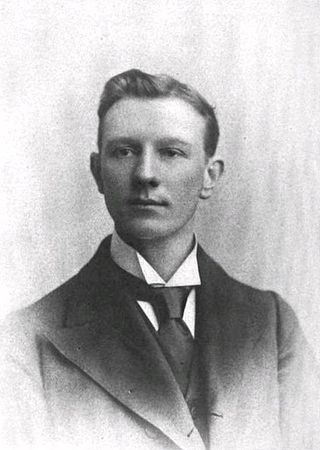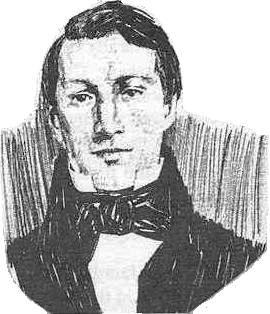Related Research Articles

The Angel Moroni is an angel whom Joseph Smith, founder of the Latter Day Saint movement, reported as having visited him on numerous occasions, beginning on September 21, 1823. According to Smith, the angel Moroni was the guardian of the golden plates buried near his home in western New York, which Latter Day Saints believe were the source of the Book of Mormon. An important figure in the theology of the Latter Day Saint movement, Moroni is featured prominently in its architecture and art. Besides Smith, the Three Witnesses and several other witnesses also reported that they saw Moroni in visions in 1829.

The Mountain Meadows Massacre was a series of attacks during the Utah War that resulted in the mass murder of at least 120 members of the Baker–Fancher emigrant wagon train. The massacre occurred in the southern Utah Territory at Mountain Meadows, and was perpetrated by settlers from the Church of Jesus Christ of Latter-day Saints involved with the Utah Territorial Militia who recruited and were aided by some Southern Paiute Native Americans. The wagon train, made up mostly of families from Arkansas, was bound for California, traveling on the Old Spanish Trail that passed through the Territory.

Robert LeRoy Parker, better known as Butch Cassidy, was an American train and bank robber and the leader of a gang of criminal outlaws known as the "Wild Bunch" in the Old West.

Body snatching is the illicit removal of corpses from graves, morgues, and other burial sites. Body snatching is distinct from the act of grave robbery as grave robbing does not explicitly involve the removal of the corpse, but rather theft from the burial site itself. The term 'body snatching' most commonly refers to the removal and sale of corpses primarily for the purpose of dissection or anatomy lectures in medical schools. The term was coined primarily in regard to cases in the United Kingdom and United States throughout the 17th, 18th, and 19th centuries. However, there have been cases of body snatching in many countries, with the first recorded case dating back to 1319 in Bologna, Italy.

The Salt Lake Temple is a temple of the Church of Jesus Christ of Latter-day Saints on Temple Square in Salt Lake City, Utah, United States. At 253,015 square feet (23,505.9 m2), it is the largest Latter-day Saint temple by floor area. Dedicated in 1893, it is the sixth temple completed by the church, requiring 40 years to complete, and the fourth temple built since the Mormon exodus from Nauvoo, Illinois, in 1846. The temple was closed in December 2019 for a general remodelling and seismic renovations, which were initially estimated to take approximately four years. Subsequent updates extended the estimated completion to 2026, for a total renovation timeline lasting an anticipated six or seven years.

Hyrum Mack Smith was a member of the Quorum of the Twelve Apostles of the Church of Jesus Christ of Latter-day Saints.

Grave robbery, tomb robbing, or tomb raiding is the act of uncovering a grave, tomb or crypt to steal commodities. It is usually perpetrated to take and profit from valuable artefacts or personal property. A related act is body snatching, a term denoting the contested or unlawful taking of a body, which can be extended to the unlawful taking of organs alone.

Rudger Clawson was a member of the Quorum of the Twelve Apostles of the Church of Jesus Christ of Latter-day Saints from 1898 until his death in 1943. He also served as President of the Quorum of the Twelve Apostles from 1921 until his death. For five days in 1901 he was a member of the First Presidency of the LDS Church.

The Salt Lake City Cemetery is a cemetery in northeastern Salt Lake City, Utah, United States, that is one of the largest city-operated cemeteries in the United States.

Joseph Standing was a missionary for the Church of Jesus Christ of Latter-day Saints who was killed by a mob near the town of Varnell, Whitfield County, Georgia, in 1879.

Symbolism in the Church of Jesus Christ of Latter-day Saints is the process whereby objects or actions have been invested with an inner meaning expressing church ideas. The Church of Jesus Christ of Latter-day Saints and its membership have adopted a number of symbols that differ from those typically used in Christianity.

Alvin Smith was the eldest brother of Joseph Smith, founder of the Latter Day Saint movement. Alvin took a leading role in helping the Smith family work toward paying their debts and building their home. His death at age 25 resulted in his younger brothers Hyrum and Joseph taking more of a leading role in family affairs. A vision by Joseph Smith showed Alvin, who was not baptized while alive, in the celestial kingdom, which is the highest of the degrees of glory. His presence in the life of young Joseph Smith and in that vision played a significant role in the establishment of the Latter Day Saint doctrines of redemption of those who die without a knowledge of the gospel, as well as the practice of baptism for the dead in the Church of Jesus Christ of Latter-day Saints.
Clarence L. Maxwell, known as Gunplay Maxwell, was a late 19th-century Old West gunfighter and businessman from Boston, Massachusetts.

The Premature Burial, also known as Premature Burial, is a 1962 American horror film directed by Roger Corman and starring Ray Milland, Hazel Court, Alan Napier, Heather Angel and Richard Ney. The screenplay by Charles Beaumont and Ray Russell is based upon the 1844 short story of the same name by Edgar Allan Poe. It was the third in the series of eight Poe-themed pictures, known informally as the "Poe Cycle", directed by Corman for American International Pictures.

Fremont Island is a 2,943.04-acre (11.91 km2) island located in Great Salt Lake in northern Utah, United States. State owned, it is the lake's third largest island after Stansbury Island and Antelope Island. The island has also been known by several other names, including mo'ko-mom-bĭtc, Castle Island, Coffin Island, Disappointment Island, and Miller Island.
Jean-Baptiste is a male French name, originating with Saint John the Baptist, and sometimes shortened to Baptiste. The name may refer to any of the following:

The Mormon Pioneer Memorial Monument is a private cemetery and memorial. It is the burial site of Brigham Young and several of his wives and children. Part of the property was dedicated to the Mormon pioneers who died making the journey to Utah from Illinois and other parts of the world between 1847 and 1869.

Redemption: For Robbing The Dead is a 2011 American Western independent film written and directed by BYU film professor Thomas Russell and starring Jon Gries, Edward Herrmann, Barry Corbin, Gregg Christensen, Margot Kidder, Rance Howard, and Larry Thomas. Redemption: For Robbing The Dead is based on actual events. The film was given an AML Award.

Henry Heath was a Mormon pioneer and lawman in the Utah Territory, United States.

Francis Hermann was an English-born American pastor, murderer and suspected serial killer. After being connected to the murder of two female churchgoers in Salt Lake City, Utah, Hermann fled the city and was never seen again. He is also suspected of murdering ex-wives and two of his children.
References
- 1 2 Jennifer Jones (November 12, 2012). "The Legend of Jean Baptiste: Grave Robber of Salt Lake City". The Dead History. Retrieved August 24, 2024.
- 1 2 3 Devitry-Smith, John (1993). "The Saint and the Grave Robber". BYU Studies Quarterly. 33 (1): 23–44.
- 1 2 3 4 5 6 7 8 Yvette D. Ison (March 1995). "Unsolved Mysteries in Utah—The Bizarre Case of Grave Robber Jean Baptiste". History to Go. Utah Division of State History. Retrieved August 24, 2024.
- 1 2 Twila Van Leer (May 30, 1995). "History of Grave Robber is Buried in Mystery". Deseret News. Retrieved August 24, 2024.
- ↑ Carole Mikita (April 7, 2012). "Notorious S.L. Grave Robber Hits the Big Screen in Story of "Redemption"". Deseret News. Retrieved August 24, 2024.
- ↑ "Redemption: For Robbing the Dead". Official Film Website. Retrieved August 24, 2024.